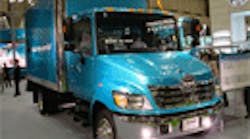Hefty export volumes combined with a growing focus on light- and medium-duty products are but two lessons a new report urges North American truck makers to absorb from their Japanese counterparts.
The study from global research firm Frost & Sullivan, titled “Strategic Insights from the Japanese Commercial Vehicle Industry,” points out that studying Japanese truck OEMs reveals effective business planning insights and global growth strategies, as they’ve been dealing with a recessionary economy for over a decade..
“Japan’s been in a recession for 10 year now, so if North America is facing slow to no-growth economic trends in the next several years, they could learn a lot from the Japanese,” Sandeep Kar, global program manager-commercial vehicle research for Frost & Sullivan, told FleetOwner. “The Japanese OEMs offer a model for survival for truck makers and Tier-1 suppliers in North America.”
Kar noted that the population of commercial vehicles in Japan has declined 25% since 1992, with commercial vehicle sales in Japan falling steadily year over year since 1996. As a result, the average age of commercial vehicles in Japan continues to skyrocket. The average age of buses, for example, hit 15.6 years in 2009, an increase of 6 years from 1981, while the average age of commercial trucks reached 11.7 years; double the average age reported back in 1975.
To balance out the dramatic and ongoing decline in domestic sales, Japanese OEMs export furiously, he explained. In 2008, exports claimed 49% of Japan’s total truck production—and that is projected to climb to 51% this year.
“In North America, by contrast, exports represent only 10% of total truck production,” Kar said. “The lesson here is that with a domestic market in regression, the only way to survive and thrive as a truck maker is to export.”
The bulk of those exports – 64% – go to the Middle East, Africa, and Asia, with smaller numbers aimed at Latin America and Europe. North America currently represents just 2% of Japan’s commercial truck exports, though that could change, warned Kar.
“The aggressiveness of the Japanese OEMs in penetrating the American and global truck markets with fleet-focused light- and medium-duty trucks indicates that things are going to get much tougher for North American truck makers in both the domestic and global arenas,” Kar said.
The lesson for North American OEMs, he stressed, is that it’s “export or die” for the future. “If the North American market for trucks keeps growing, then have strong exports is a ‘win-win’ situation. But if the domestic market keeps declining, it is exports that will save you.”
Frost & Sullivan’s research also found that worldwide demand for commercial trucks is breaking down into two distinct camps-- heavy- and light-duty models, with demand for medium-duty doing a slow fade except for in certain places, such as Russia.
“The urbanization of many developing nations is leading to much more compact cities, dominated by narrow streets,” Kar pointed out. “That necessitates smaller, highly maneuverable light vehicles, whereas the heavy vehicles are needed to move goods between those cities. And that ‘polarization’ of truck classes worldwide is only going to speed up.”
Not only do Japan’s truck makers specialize in light-duty trucks, they also have an advantage with hybrid technology, as it is Japanese-built powertrains and batteries that make up the lion’s share of the “guts” in most hybrid commercial trucks today – including those sold in the U.S.
“Diesel-electric hybrid truck growth will be healthy through 2020 from what we see now,” said Kar. “What comes out of the climate conference in Copenhagen may even accelerate that. The challenge is that Japanese truck makers have the edge in exports and in hybrid technology; they have the global market footprint right now. Competing against that by North American truck markers will pose difficulties.”




